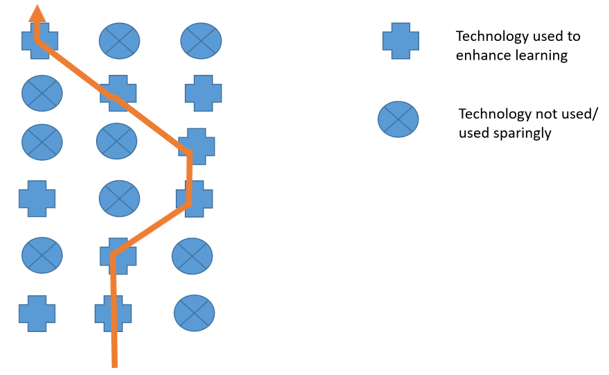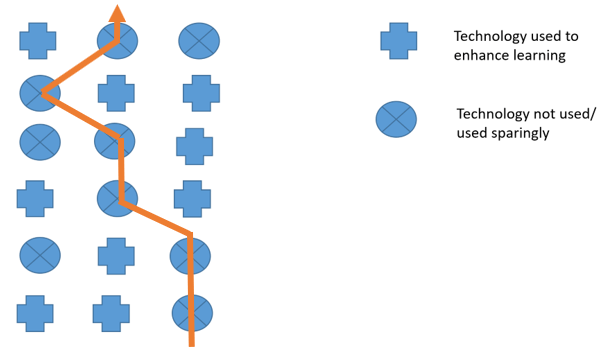Students need to be prepared for our modern world. Academic success is vital, but a knowledge of technology and how to use it is also vital. Other things are also very important in schools; things such as learning some social skills, collaboration, fitness and being part of a sporting team, music and other co-curricular activities and so on are also very important. However, they are things schools have been doing for a long time and are often better integrated into traditional classrooms.
The growth of Science, Technology, Engineering, the Arts and Mathematics (STEAM) and more technology in the classroom has added to a sometimes heterogeneous educational technology environment. In some cases, the use of computers and technology-enhanced learning is still not consistent across classes in the same school, let alone consistent across schools. Yet our students cannot afford an inconsistent approach.
Consider a primary school with three classes in a year level, as represented in the diagram above. Imagine that some teachers have embraced technology to enhance learning, while others find the change more difficult and thus use it sparingly. Consider the possible progress of an individual student over the six years represented. This is shown by the red line. The student could complete six years of education with minimal contact with technology.
Consider the progress of another student. This student could spend each year exposed to technology and would have the rewards associated with technology-enhanced learning.
These are two students in the same school, yet their experiences vary greatly. This would be very difficult to explain to a parent. We are striving for equity in education in all areas, yet clearly some students may be disadvantaged.
The Solution?
Obviously, this is a simplification and it illustrates two extremes. Do we have equity in all other areas? Probably not. However, it does highlight a significant problem.
So, what can be done? Obviously, we all need to be working to a useful implementation of the National Curriculum.
We also need to ensure there is sufficient professional development for teachers, sufficient support for them in implementing change successfully in the classroom and sufficient resources to make this all possible.
Once we get each school ‘right’, perhaps we can work on getting all schools right, where every student in every school in Australia has equal access to the core technology to enhance learning. Is this idealistic? Yes. Is it difficult? Yes. Is it possible? Yes. Well-planned and well-implemented whole-school change is necessary. It is not a luxury that should be placed in the too difficult category. Our students deserve this and more!


Latest posts by Peter West (see all)
- The 20:20:60 Rule of eLearning Evolution - October 11, 2022
- Is your school ready for an LMS? – The Data Design Continuum (DDC) - August 25, 2022
- Is your school ready for an LMS? – The Course Design Continuum (CDC) - September 7, 2021
You must be logged in to post a comment.


There are no comments
Add yours